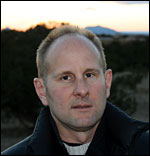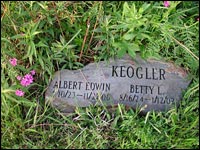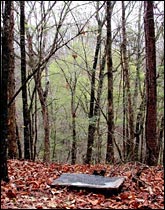
Resting in peace at Ramsey
Creek.
Photo: Memorial Ecosystems.
“I’d prefer to be put in the ground, under a tree,” says Joe Sehee, contemplating his inevitable demise. “But I don’t want to go in the ground with anything, I just want to be buried in a simple pine box or shroud, and that’s it.”
If Sehee has given his preferences a lot of thought lately, it’s not that he’s planning to shuffle off this mortal coil any more imminently than the rest of us — it’s just that, as executive director of the Green Burial Council, it’s his job.
The “anything” Sehee wants to avoid going into the ground with is the embalming fluid, concrete, steel, and hardwoods that typically get buried along with the dead. For the past four years, he has been seeking a way to bring environmental consciousness to the “death-care” industry. Now the Green Burial Council is unveiling the first U.S. certification for eco-burials, a move that Sehee hopes will harness the power of the $25 billion death-care industry — which oversees 1.8 million burials in the U.S. each year — in the service of conservation.

Joe Sehee.
“I’ve talked to a couple thousand consumers over the last four years, and I know what’s driving them [to look into green burials],” Sehee says. “Allowing people to feel as though their last act on earth contributes to a positive purpose connects them in an almost religious way to this concept. It makes people’s eyes sparkle.”
The new certification standards will indeed help consumers plan their earthly end. But they’ll also help the conservation community. Sehee, currently helping to establish a green cemetery near Santa Fe as part of an eco-development managed by the Commonweal Conservancy, hopes his efforts will eventually protect a million acres around the world.
Death-Care Be Not Proud
While there’s been a buzz about green burials for several years, the concept has yet to catch on widely. “There have been dozens and dozens of articles about it,” says Ron Hast, publisher of industry magazines Mortuary Management and Funeral Monitor, “but it is not a trend. It is a cottage industry that cemetarians do not find worth the investment to provide.”
Indeed, the two most prominent green cemeteries — Ramsey Creek Preserve in South Carolina and Fernwood in Northern California — have performed fewer than 200 green burials between them in the past five years.
But according to Sehee, there’s a major obstacle: the death-care industry itself. The prevailing marketplace makes it hard for consumers — who have enough trouble picking paper or plastic — to evaluate their end-of-life options, especially if they haven’t planned ahead. A bewildering array of options, regulations, and misinformation awaits, compounded by the emotional circumstances in which such decisions are usually made.
That’s where the new standards, developed in consultation with consumer advocates, land trusts, and landscape architects, come in. Sehee hopes to do for death-care what organic standards and Fair Trade certification have done for the supermarket. “We’re making it easy for consumers to distinguish between environmentally and consumer-friendly providers and those who are not operating that way,” he says. “That, to me, is the crux of this issue.”
The Council has issued two sets of guidelines, for Natural Burial Grounds and Conservation Burial Grounds. The first outlines requirements for eco-friendly cemeteries, governing everything from visitation to landscaping. It bans toxic embalming, vaults, and landscape-inappropriate monuments, and requires biological evaluation of the site, habitat restoration with native plants, and the establishment of an endowment fund to ensure the burial ground continues to adhere to the standard.

Love me like a rock.
Photo: Memorial Ecosystems.
But it’s the second type of certification that takes things in a new direction. The Conservation Burial standards help land trusts and other groups use a combination of Natural Burial certification and conservation easements to further their stewardship mission. The Green Burial Council — which includes a board member who’s a senior vice president at the Trust for Public Land — believes certification has the potential to not only bring in revenue, but also to help ensure that land remains protected. “Burial is another layer of protection,” Sehee says. “It consecrates the land and offers another barrier to development.”
Ted Harrison, founder and president of the Commonweal Conservancy, says conservation burial has been under discussion within the land-trust community for the past decade, but without standards, land trusts haven’t had the confidence to undertake it on their own. “The standards ensure a better grounding,” he says, “a level of integrity that gives us a higher level of confidence than if we were trying to figure it out on our own.”
Facing Facts
By providing legally enforceable and transparent guidelines, Sehee hopes to move conservation burial from concept to reality, and quickly: he estimates that a million acres will be protected over the next decade. He’s clearly still at the true-believer stage of his consumer movement, when such claims sound either ludicrous or audacious, depending how you look at it.
Either way, the concept will soon be put to the test: this fall, Sehee expects a handful of facilities in Southern California to become certified, and by this time next year he expects “dozens and dozens” across the country. Since the certification system will be funded by fees from certified facilities, Sehee’s next challenge is to make sure consumers ask for the services.
“We have these standards,” he says, “and we have a very credible entity that’s put them forth, but no one knows about them. My challenge right now is to make consumers realize that it’s in their best interest to look for the council seal of approval.”
It’s the sort of chicken-and-egg conundrum any marketing campaign has to face. But in this case, there’s an added wrinkle. “There’s a cultural barrier to green burial in mainstream culture,” says Kim Sorvig, a landscape architect at the University of New Mexico who serves as an advisor to the Green Burial Council. “We have a detachment or denial about people dying. You can go your entire life and never be confronted with the actual facts of death.”
Sorvig says planning for conservation burial can change the way people view their own deaths, and thus their lives. “People are depriving themselves of important psychological or spiritual connections by playing along with the idea of death embedded in the conventional culture,” says Sorvig. “This offers great potential for engaging people now and helping them connect with the cycle of birth and death as a part of human ecology — it’s a very meaningful use of the earth.”
And that, ultimately, is the legacy Sehee is after; a way to ensure that, even as he lies in his simple pine box, he’ll still be working to protect the planet: “I hope that I’m part of something bigger, protecting an endangered landscape — in a Green Burial Council-certified Conservation Burial ground.”



